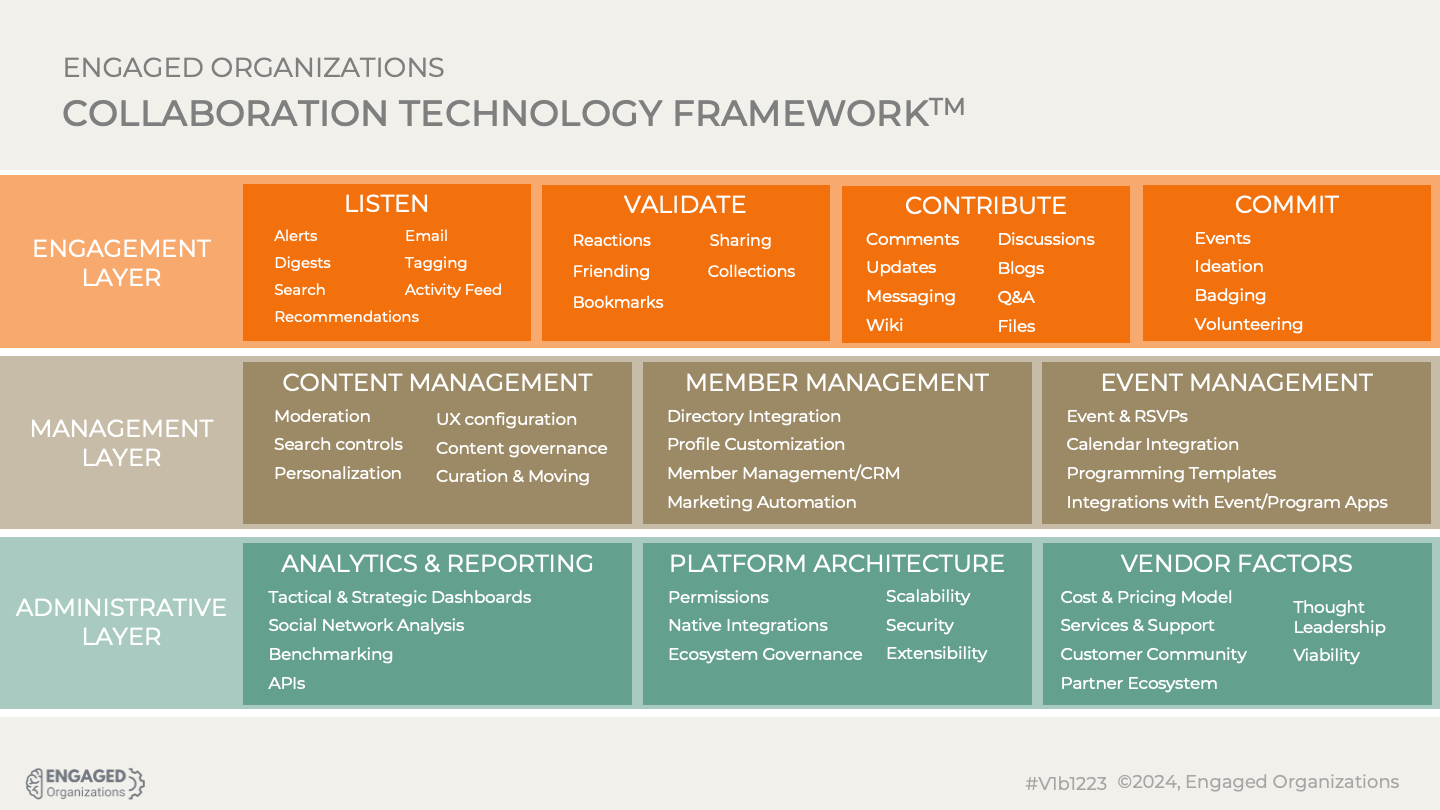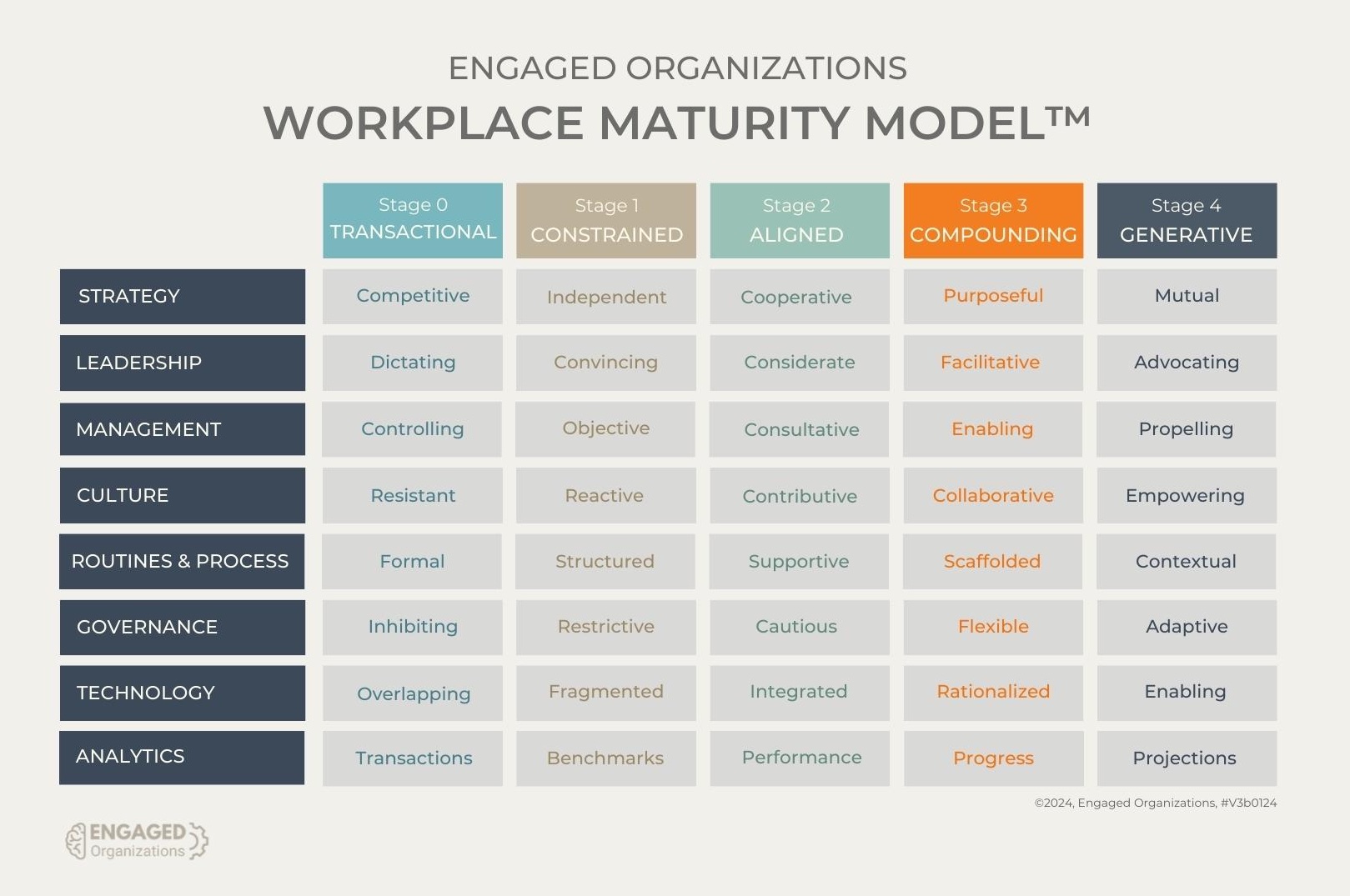The enterprise collaboration technology market has changed significantly since I was IDC’s first social software market analyst in 2007.
On the external/customer side, large social networks gobbled up the market, which reverted to a renewed emphasis on advertising vs engagement as social network operators squeezed out more revenue and profits. On the internal side, Microsoft and Google lead a group of unified communications vendors, which include group and community applications but with little nuance or sophistication, and they have largely reverted to a new version of chat and communications channels.
Still Trying to Solve Human Problems with Technology
It seems like, despite the need for virtual collaboration driven by the pandemic, the market and options for customers are not that different than they were in 2005, which is sobering, albeit with a promise that generative AI, like enterprise search in 2005, will solve the problem.
It all makes me wonder when we will learn to stop trying to solve human problems with technology.
Question for those of you who work in enterprise IT, particularly those who focus on collaboration.
How do you reconcile/combine the following sets of technology platforms to provide a clean employee experience?
– Intranet
– CMS/DMS (Content Management, Document Management, Digital Asset Management Systems) other than intranet
– Collaboration
– Email/Communications
– Work/Workflow/Project Management
– Digital Experience/Recognition
– Groups and Communities
– Search & KM
– Learning/LMS
It seems like the market has just gone toward unified communications platforms (Microsoft, Google, Cisco, Zoom, etc) that have most of these things, even if each set of features is not particularly good.
I am thinking about stepping back into doing market analysis and looking at technology from a behavioral/workflow orientation. It seems to be very fragmented and oriented around features instead of around employees’ needs and how value is generated.
Comments From Collaboration Technologists in My Network





My Assessment of Enterprise Collaboration
I have a lot of people with rich experience and insightful perspectives in my network. Many rightly identify data integration and coherence as the core issue from a technology perspective; it is a considerable issue and without it, everything else is a mess.
Three key topics and issues emerged from the conversation:
- Data integrity, integration, and architecture.
- Definition of collaboration in different contexts.
- Incorporating a range of individual and team collaboration preferences.
After working with and watching the collaboration technology market for almost two decades, my perspective is that enterprise and institutional customers do not invest the time to step back, reflect on, and assess what their organizations need from a business and strategy perspective. A big part of the issues in collaboration stems from governance and operational structures, but these are often ignored and too often pinned on superficial interpersonal conflict and lack of trust. While there are certainly things that can be addressed at a team level to improve collaboration, it will always be fleeting if the governance of the organization in which teams sit counteracts trust and healthy collaboration. It is hard to fix governance issues, and the most common approach in large, complex organizations is to over-complicate them.
I believe complexity needs to be addressed with radical simplicity; I am a fan of finding the simple, repeating patterns (fractals) that apply to every work process – and then tracking simple data and metrics that everyone can understand. In organizations, these fractals and patterns are the work behaviors used over and over in a vast array of different workflows and situations. Designing an organizational system around these behavior patterns accomplishes a few things:
- It is specific and measurable.
- It allows analysts and strategists to see the differences that impact performance between different groups in a way that managers can address.
- It is the way to see the impact of engagement in quantifiable terms that can be translated into financial measurement.
- It is actionable for individuals, managers, and executives and creates an cohesive organizing principle to align tactics, operations, and strategy.
It is, however, much easier to buy technology, cross your fingers, and hope it helps.
AI to the Rescue?
There is a lot of hope pinned on generative AI to solve these confounding issues. However, good results, even if the AI data source is comprehensive and clean (a big if), are predicated on some sophisticated self-awareness on the part of people who use it, which include:
- Knowing the right questions to ask is more complex than it seems. It requires knowing that the answer might exist, how the expertise is framed, and the language used.
- Understanding and being able to articulate the context and nuance that impacts information.
- Knowing to identify when systems are returning the wrong or incorrect information. We see the enormity of this in issues with misinformation on the public web.
- Articulating the format and nuance needed to use information effectively.
Once generative AI produces answers and options, we will still be left with the need to create consensus between people and groups. The best answer, logically, may still not be the right answer in many contexts. So generative AI will help with some things, but it still won’t address the human problems, which is what unlocks the most significant value of collaboration.
Where does that leave the market?
Do We Need New Leadership in Enteprise Collaboration?
Some things have progressed significantly and improved how easy it is to work together virtually; solutions like Miro, Sigma, Asana, Trello, and many more; structured tools that allow us to do work together have improved dramatically. Zoom and Google Meet have made virtual meetings much easier. Generative AI’s most significant contribution may be recording, transposing, and summarizing meetings. That is a big part of collaboration on a day-to-day level, but it is still relatively transactional, improving tactical production tasks.
However, what about collaboration that requires getting buy-in, sparking new ideas, building trust, finding consensus, giving someone complex feedback, reducing duplication, and negotiating conflict? I am not sure how much headway we have made on that front. If people are not engaged, do not care, are not motivated, and are not self-reflective, no amount of technology can solve those human collaboration problems.
While human collaboration issues cannot be addressed by technology when individuals are motivated and engaged, collaboration technology is transformative in accelerating the speed, quality, and quality of human work; I know because I have experienced it. In this area of collaboration, which is arguably more strategic, we seem to have made very little progress. In fact, things seem to have worsened as short-term financial influences increasingly dominate strategic decisions.
Read any executive job description, and the initial requirements are all about this type of collaboration; I am always curious whether the objectives and KPIs for these roles reflect the job descriptions, though, because I have seen very little progress in making the governance changes that would allow those objectives to be fairly measured.
We need IT, HR, COOs, CFOs, and CEOs to prioritize the more challenging work of auditing, rationalizing, and aligning business strategy, financial reporting, and governance with the capabilities of an organization’s infrastructure and its employees. It will require significant investment. However, until the entire system is rationalized, efforts to adapt that only focus on technology or job descriptions or workflows or finances will ultimately create more friction than value.
It is one of the reasons I incorporated over a decade of research on community systems and how their structure impacts engagement to create the Workplace Maturity Model. That research convinced me that communities are the operational approach that best produces human performance and excellence – and is what is missing in the governance of most organizations and institutions – even those with strong democratic missions.
Limited By What We Believe is Possible
From my perspective, the biggest challenge in enterprise collaboration and culture is that leaders do not believe that most cultural and interpersonal friction in organizations can be eliminated. But I know from experience, both in my own work life and from client work, that work doesn’t have to be a constant battle with our colleagues, managers, and executives.
Work can feel easy. It can feel energizing. It can feel fun. It can feel joyful. It can feel empowering.
We expect too little of work cultures rather than too much.
When leaders expect too little, they don’t even seek out solutions. As with using generative AI effectively, the best results require that we first believe in its possibility.






